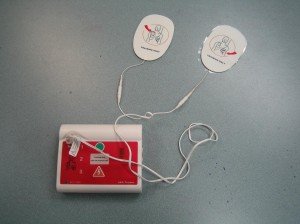Sudden cardiac arrest can occur without warning. Even though it commonly occurs among adults with coronary artery disease, the condition can occur in individuals of all ages. By using an AED or automated external defibrillator, it can help restore a heartbeat in order to increase the chances of survival. You can learn how to use an AED in any AED and CPR course.
Steps in using an AED machine

- Initially, you have to ensure that the AED machine is operating optimally and in a convenient location. If a bystander is present, request him/her to call for emergency assistance.
- Check if the individual is in cardiac arrest with no pulse, breathing or consciousness. Always remember that an AED must not be used on an individual below 8 years old. For those who are at least 8 years old, position the electrodes and use the machine in the same manner as with the adults.
- Switch on the AED machine by pressing on the ON/OFF button. A light will turn on indicating that the machine is ready.
- You have to prepare the individual for the placement of the electrodes by positioning him/her with the back on a hard surface, remove the clothing from the upper torso as well as the excess hair for the electrode sites and clean the area if it is dirty. If the skin is cleaned using water, dry the area completely using a gauze or towel to prevent the risk of electrocution.
- Place the electrodes firmly on the chest. Position the electrode with the plus or heart sign lateral to the left nipple on the left side beneath the arm. Position the other electrode on the upper right torso close to the sternum under the collar bone.
- Connect the electrode cord to the AED. The device will present “Connect Electrodes” on the display screen until the cords are connected properly.
- Follow the messages on the display screen and voice prompts. The machine will instruct you to “Stand Clear”. This means that you should not touch the individual and the AED machine. The machine will prompt “Shock Advised” after automatic analysis. The machine will then prompt “Stand Clear” and “Push to Shock”. Once a shock is delivered, the machine will assess the individual again.
- You have to continue to follow the prompts. After the analysis of the first shock, the machine might prompt you to deliver another shock. If the device prompts, “No Shock Advised”, it will prompt you to “Check for Pulse”.
- If the machine prompts “If No Pulse, Start CPR”, you have to perform CPR. After CPR is performed, the machine will prompt “Check for Pulse”. At this point, you can repeat starting from step 7 up to step 10 until the medical team arrives on the scene.
Important considerations to bear in mind
If the individual is thin, you have to contour the electrodes around the ribs when pressed into place in order to ensure good skin contact. As for obese individuals or those who have large breasts, the electrodes must be applied to a flat area if possible. In case the individual has a pacemaker, using an AED will lead to the malfunction of the device. With this in mind, the electrodes must be positioned away from the pacemaker if possible.
